Key Takeaways
Hello Heart Hero.
We know navigating your heart health can feel overwhelming, especially when you come across confusing terms like EKG and ECG. If you're feeling a bit skeptical about the usual healthcare runaround and are looking for clear answers, you've come to the right place. The simple truth is there's no medical difference between an EKG and an ECG. They are just two different acronyms for the exact same test, which measures your heart's electrical activity.
So, why the two names? It all comes down to a simple language difference.
What’s the Difference Between EKG and ECG?
We get it, health information can be confusing, especially when you’re trying to take control of your well-being. It can be frustrating when simple things seem complicated for no reason. Let's clear this one up for good. The term EKG comes from the original German name for the test: Elektrokardiogramm.
ECG is simply the English translation: Electrocardiogram.
Whether a healthcare professional uses "EKG" or "ECG" often just comes down to habit or where they trained. In the United States, for instance, "EKG" is still widely used, partly to avoid any mix-ups with "EEG," which is a test for brain waves (electroencephalogram).
No matter which term you see, the goal is the same: to give you a clear picture of what your heart is doing. To learn more about what those squiggly lines mean, check out our guide on what is a normal ECG reading.
EKG vs ECG At a Glance
To make it crystal clear, here’s a quick summary of the key points.
Ultimately, both acronyms refer to the same invaluable tool for monitoring your heart's health. The only difference is in the letters, not the test itself.
The Simple History Behind the Two Names
To get to the bottom of the EKG vs ECG debate, it helps to take a quick look back in time. The story begins with a Dutch doctor, Willem Einthoven, who invented the first practical electrocardiogram. At that point in history, many early medical breakthroughs were heavily influenced by German science.
This influence led to the widespread adoption of the German term Elektrokardiogramm, which was naturally shortened to EKG.
Even as English became the more dominant language in medicine, many doctors, especially in the United States, stuck with EKG. It was a practical choice, really, to avoid any verbal confusion with EEG, the acronym for electroencephalogram, which is a completely different test that measures brain activity.
This bit of history shows that the different names have a logical origin and aren't just there to be confusing. Knowing this can make all the medical jargon feel a little less intimidating.
How an Electrocardiogram Actually Works
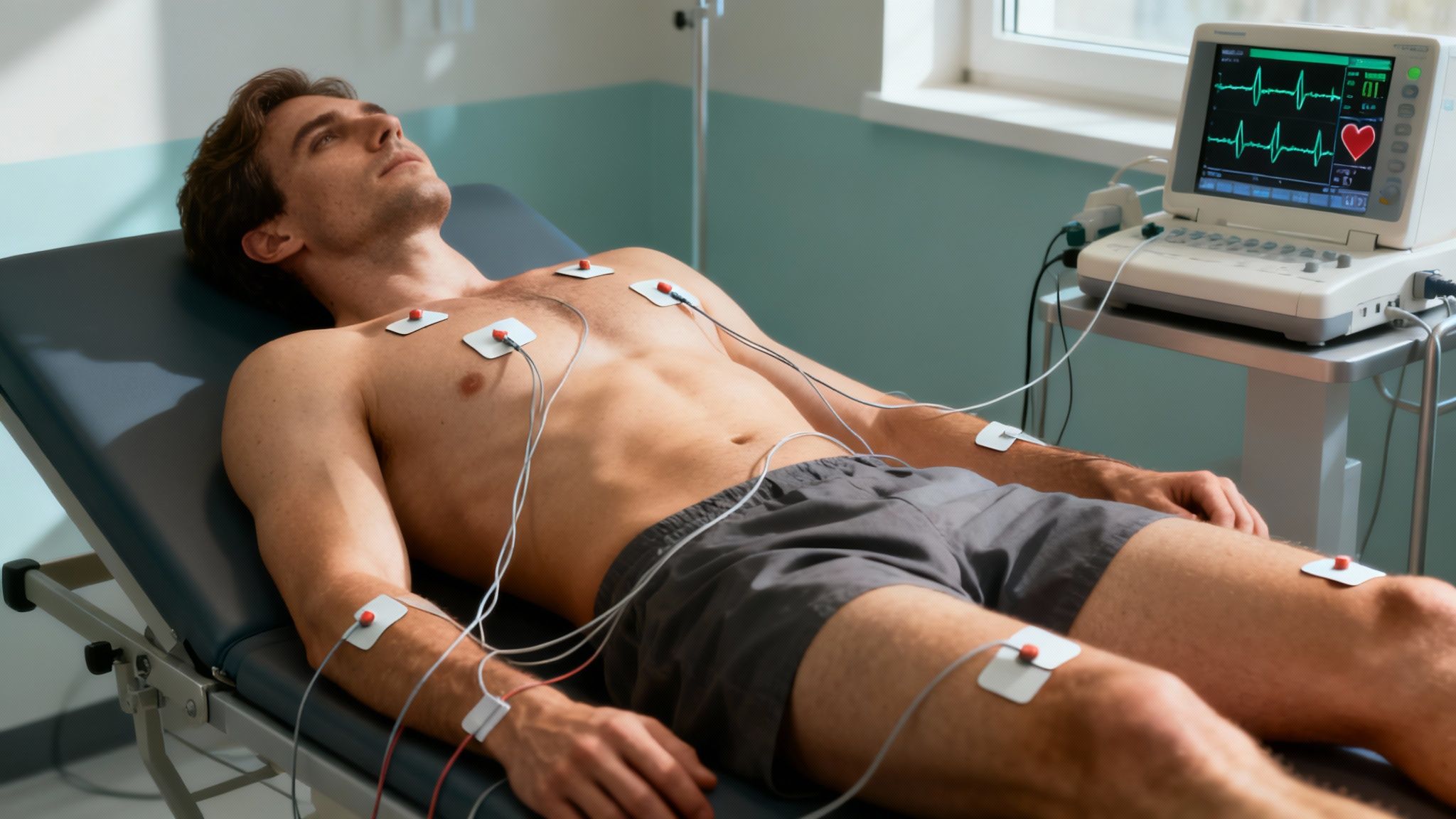
Whether you call it an EKG or an ECG, the process itself is surprisingly simple and completely painless. When you're in a doctor's office, a technician will attach several small, sticky sensors called electrodes to your chest, arms, and legs. These little sensors are incredibly sensitive; their only job is to pick up the faint electrical signals your heart produces with every single beat.
The machine connected to these electrodes then does the rest. It records all this electrical activity and translates it into the familiar series of waves you see on a screen or a strip of paper. This visual readout is your electrocardiogram, a detailed snapshot of your heart's rhythm and electrical function.
A standard clinical EKG often uses 12 different leads, or viewpoints, to create a comprehensive, 3D picture of your heart's health.
If you're curious about what all those squiggly lines really mean, our guide on how to read an ECG is a great place to start. Understanding the basics can make your health conversations much more meaningful.
Your Smartwatch EKG and At-Home Heart Monitoring
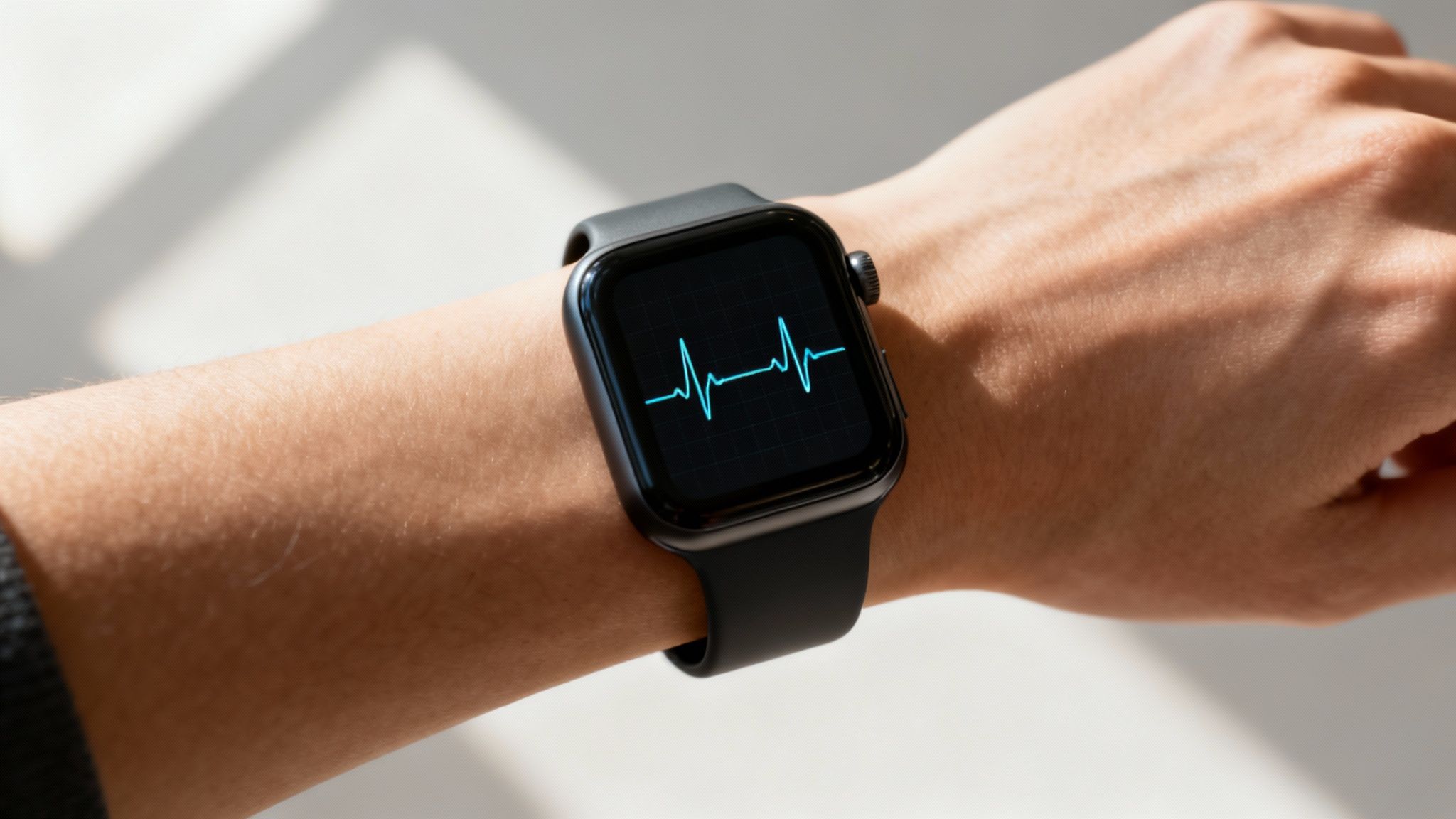
It’s an amazing feeling, isn't it? The power to check on your heart is no longer confined to a doctor’s office, it’s right there on your wrist. For many who feel unheard or rushed in a traditional medical setting, at-home EKG devices, especially those built into smartwatches, have truly put you in the driver’s seat of your own health.
This technology allows you to record your heart’s electrical activity and screen for irregularities like Atrial Fibrillation (AFib) from literally anywhere. Feeling a weird flutter? Just take a quick EKG. It’s that simple.
The increasing demand for mobile EKG devices is driven by the growing interest in proactive health monitoring. More individuals are adopting these devices to keep track of their heart health.
It's important to remember what your watch can, and can't, do. A single-lead EKG from your wrist is a fantastic screening tool, but it doesn't replace the comprehensive 12-lead diagnostic test a cardiologist performs. For some practical tips on getting a good reading, check out our guide on how to take an ECG with your Apple Watch.
Comparing Clinical EKGs with Wearable EKGs
Let's clear things up. When people talk about EKGs, they could be referring to two very different things: the one you get at the doctor's office or the one right on your wrist. Both are incredibly useful, but they serve different purposes.
Think of it this way: a clinical 12-lead EKG is the gold standard for diagnosing major cardiac events, like a heart attack. On the other hand, the single-lead EKG on your wearable is a powerful screening tool, perfect for keeping an eye on your heart over the long term and catching those brief, fleeting rhythm changes that might otherwise go unnoticed.
This infographic breaks down the key differences at a glance, from the number of leads to the best situations to use each one.
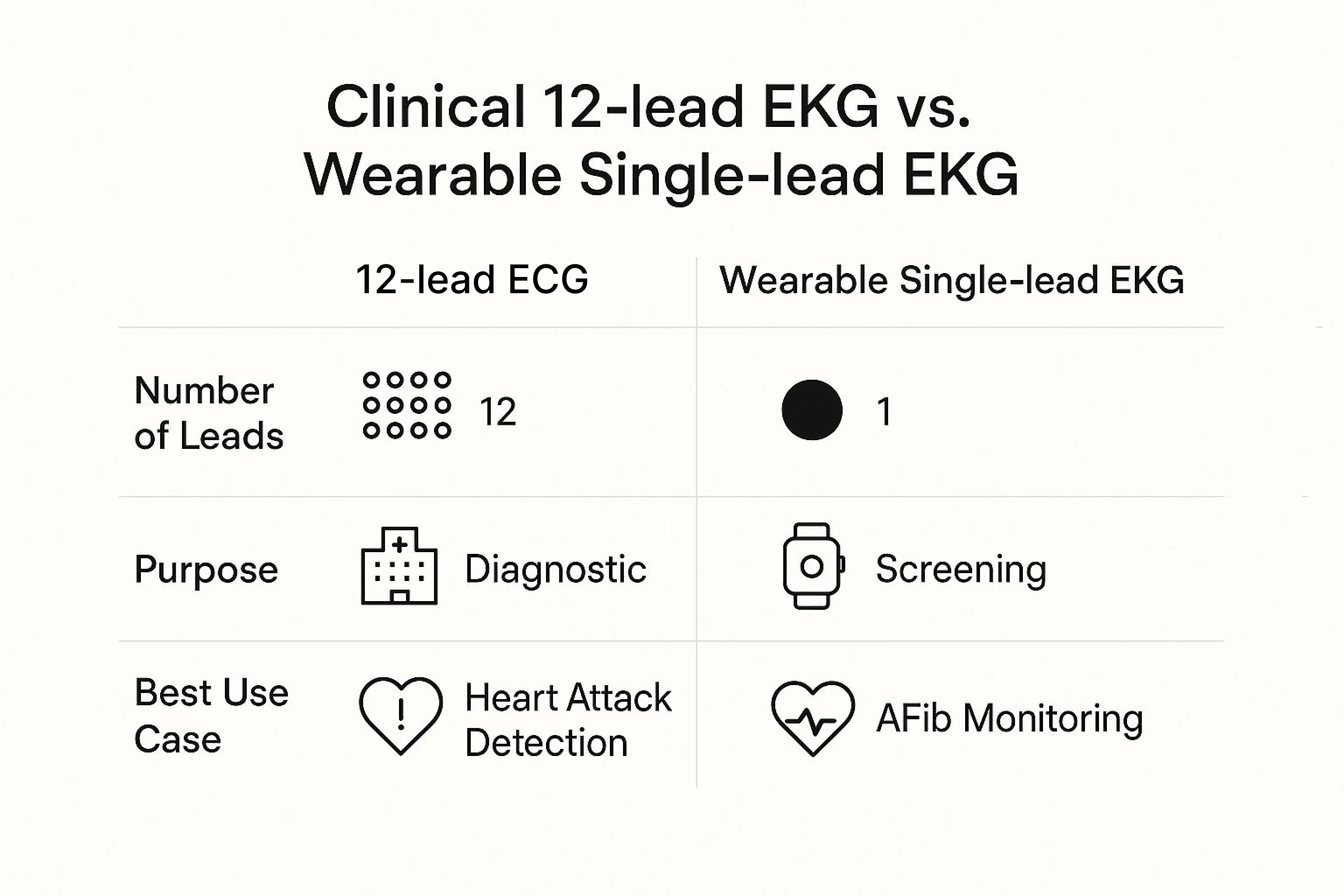
As you can see, each device plays a unique and valuable role in managing your heart health. To help you better understand the specifics, here's a more detailed comparison.
Clinical 12-Lead EKG vs. Wearable Single-Lead EKG
Ultimately, these two types of EKGs aren't competitors, they're partners in your healthcare. Your watch can alert you to a potential issue, and the clinical EKG provides the detailed picture your doctor needs for a definitive diagnosis.
The rise of at-home monitoring is a huge step forward for preventative care, with the remote cardiology market growing by nearly 5% each year. Knowing how accurate your watch's ECG is is the first step in using it as an effective tool for your health.
Making Sense of Your Watch's EKG Reading
So, you've got an EKG reading from your watch... now what? If you've ever seen an “unclassified” or “inconclusive” notification pop up, you know that unsettling feeling. It’s natural to feel a little anxious when you’re trying to stay on top of your health, and you shouldn't have to figure out this complex data by yourself.
That’s exactly where a service like Qaly comes in. Instead of leaving you guessing, we connect you with certified technicians who know how to interpret your smartwatch EKG. They turn that raw data into a clear, personalized report, written in simple terms you can actually understand.
Getting an expert analysis of your wearable's EKG cuts through the confusion and gives you real peace of mind. It’s about getting the information you need, when you need it, without having to wait for a doctor's appointment. This kind of accessible support helps you stay informed and in control of your heart health.
Your Top EKG and ECG Questions, Answered
We’ve gone through a lot of the technical details, but you probably still have a few practical questions. That’s perfectly fine. Let's clear up some of the most common ones.
Should I Use EKG or ECG with My Doctor?
Honestly, it doesn’t matter. Feel free to use whichever term comes to mind. In the United States, "EKG" is incredibly common, but every single medical professional will also know "ECG" instantly.
Your doctor will understand you perfectly either way. What really matters is that you're communicating your concerns and sharing the data you’ve collected.
Can My Smartwatch EKG Replace a Doctor’s Visit?
No, and it's important to understand the difference. Think of your smartwatch EKG as a powerful screening tool, not a diagnostic one. It’s fantastic for catching potential rhythm issues like Afib over long periods, but it simply can't diagnose something like a heart attack.
Always use your wearable's data to have a better conversation with your doctor, not to replace their professional medical advice.
Your watch is like an early-warning system. It flags potential issues and gives you concrete data to discuss, but it doesn't see the whole picture that a clinical, 12-lead EKG provides in a hospital setting.
What Should I Do If My Watch Shows an Inconclusive Reading?
First off, don't panic. An "inconclusive" or "unclassified" reading is very common. It can be triggered by simple things, like moving your arm during the reading or not having good skin contact with the watch. Rather than worrying about what it might mean, see it as a signal to get a clearer answer.
Instead of guessing, you can have your smartwatch EKG reviewed by a certified expert for a clear, human interpretation.
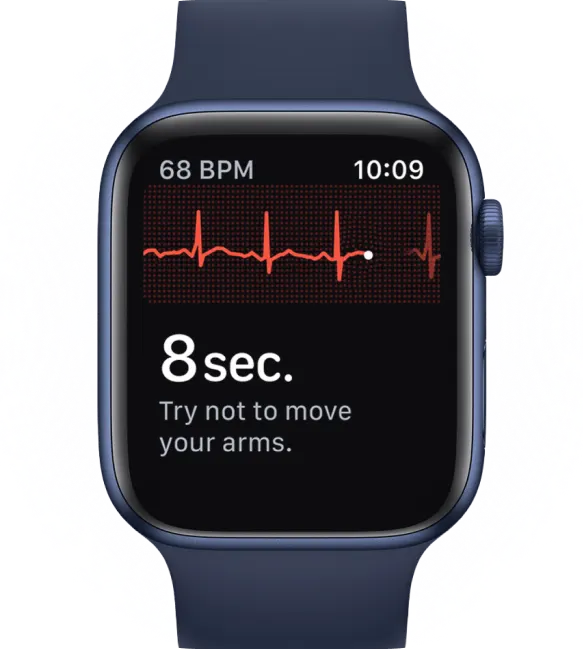


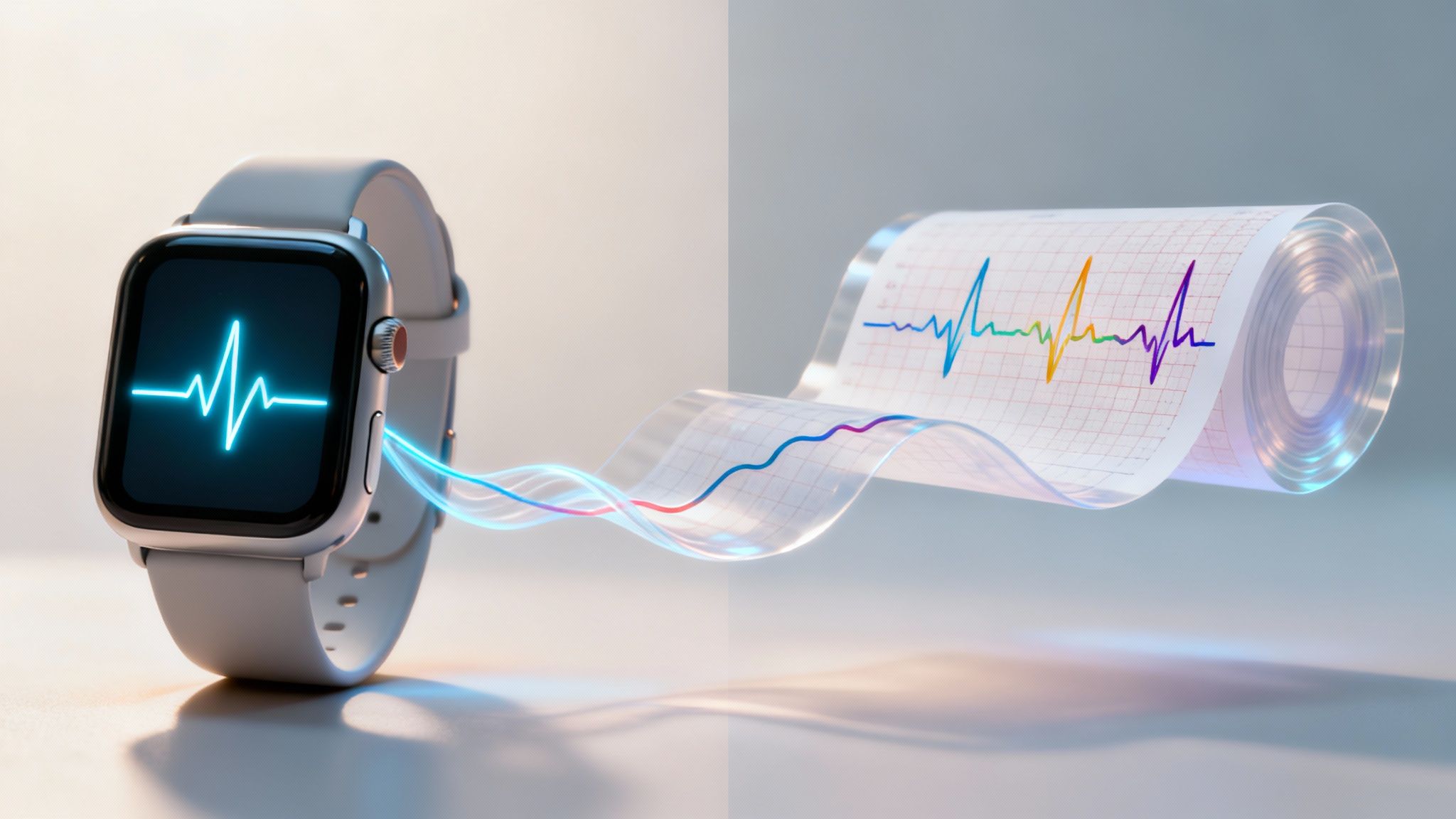






.png)
.png)